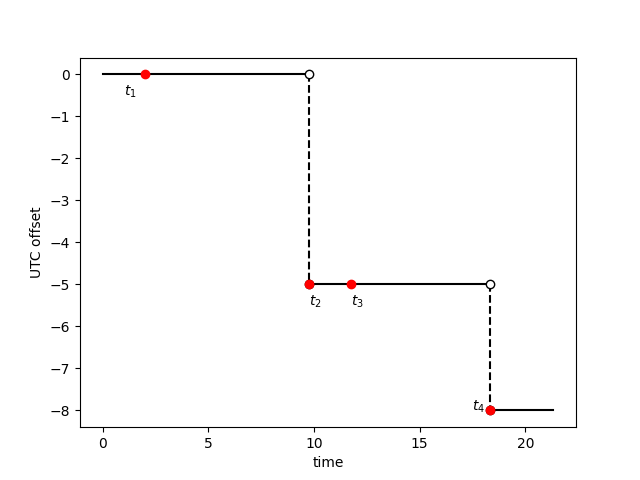Ship Time
I recently traveled to Ireland, and I had a thought about jet lag. The flight from Dublin to San Franciso — with a layover in New York — is 16.5 hours. The usual way I would experience time during this flight is

The flight from Dublin to New York takes off at $ t_1 $ and lands at $ t_2 $, and I adjust my clock back by 5 hours. I live on New York time for the duration of my layover plus the duration of the second flight from New York to San Francisco — which takes off at $ t_3 $ and lands at $ t_4 $ — at which point I adjust my clock back another 3 hours.
Here's my thought: this graph has two big discontinuities, which leads to me being pretty confused about what time it is by the time I land in San Francisco. Would my jet lag be less severe if I did many microcorrections to the time, rather than two big ones?
Here's what I did: the moment I boarded my plane in Dublin, I put my phone in manual clock mode. Every 50 minutes, I set my clock back 20 minutes until I was on correct San Francisco time. Here's a graph of my lived experience of time during my flight — overlaid onto the previous graph.

I made about 25 corrections over the 17 hours I was traveling. I tried not to look at any clocks besides my phone. This was surprisingly difficult — clocks are everywhere and we don't usually notice them! I also tried not to look at my phone too much just after a correction because I mostly wanted to see if I could trick myself into thinking that time was moving slower, rather than periodically going backwards. Ideally, the airline would make the plane's clock run slower and everyone would be on the same time. I call this ship time. Ship time involves slowing down — or speeding up if you're going the other way — your clock so that you gradually transition to a new time zone. You attempt to eat and sleep at the normal time according to ship time.
Because I was living on ship time by myself, this quickly became confusing. I tried not to listen when the pilot said the local time when we landed, because I was still an hour ahead of eastern time at that point. I had to move directly to my transfer gate without stopping for anything because I didn't want to think too hard about what time it "actually" was, and I didn't want to miss my connection (if my first flight had been delayed, I likely would have abandoned the experiment to ensure I didn't miss my flight). Ship time didn't catch up with pacific time until an hour or two after my flight landed.
Did it help? Not really! I still got hit pretty hard with jet lag on my way back. But I had a fun time.